Ministry of War of Japan

The Army Ministry of Japan (陸軍省 Rikugun-shō), more popularly known as the Ministry of War of Japan, was the cabinet-level ministry in the Empire of Japan charged with the administrative affairs of the Imperial Japanese Army (IJA). It existed from 1872 to 1945.
History
The Army Ministry was created in April 1872, along with the Navy Ministry, to replace the Ministry of the Military (兵部省 Hyōbushō) of the early Meiji government.
Initially, the Army Ministry was in charge of both administration and operational command of the Imperial Japanese Army. However, with the creation of the Imperial Japanese Army General Staff in December 1878, it was left with only administrative functions. Its primary role was to secure the army budget, weapons procurement, personnel, relations with the National Diet and the Cabinet and broad matters of military policy.
The post of Army Minister was politically powerful. Although a member of the Cabinet after the establishment of the cabinet system of government in 1885, the Army Minister was answerable directly to the Emperor (the commander-in-chief of all Japanese armed forces under the Meiji Constitution) and not the Prime Minister.
From the time of its creation, the post of Army Minister was usually filled by an active-duty general in the Imperial Japanese Army. This practice was made into law under the "Military Ministers to be Active-Duty Officers Law" (軍部大臣現役武官制 Gumbu daijin gen'eki bukan sei) in 1900 by Prime Minister Yamagata Aritomo to curb the influence of political parties into military affairs. Abolished in 1913 under the administration of Yamamoto Gonnohyōe, the law was revived again in 1936 at the insistence of the Army General Staff by Prime Minister Hirota Kōki. At the same time, the Imperial Japanese Army prohibited its generals from accepting political offices except by permission from Imperial General Headquarters. Taken together, these arrangements gave the Imperial Japanese Army an effective, legal right to nominate (or refuse to nominate) the Army Minister. The ability of the Imperial Japanese Army to refuse to nominate an Army Minister gave it effective veto power over the formation (or continuation) of any civilian administration, and was a key factor in the erosion of representative democracy and the rise of Japanese militarism.
After 1937, both the Army Minister and the Chief of the Army General Staff were members of the Imperial General Headquarters.
With the defeat of the Empire of Japan in World War II, the Army Ministry was abolished together with the Imperial Japanese Army by the American occupation authorities in November 1945 and was not revived in the post-war Constitution of Japan.
Organization
- Under-Secretary of the Army (Vice Minister)
- Military Affairs Bureau
- Personnel Bureau
- Weapons Bureau
- Army Service Bureau
- Administration Bureau
- Intendance (Accounts and Supply)
- Medical
- Judicial Bureau
- Economic Mobilization Bureau
- Aeronautical Department
- Economic Mobilization (abolished in April 1945)
The Army Ministry and Imperial General Headquarters were located in Ichigaya Heights, which is now part of Shinjuku, Tokyo.
Ministers of Army of Japan
| No. | Name | Portrait | Cabinet | Term of Office | |
|---|---|---|---|---|---|
| Start | End | ||||
| 1 | Ōyama Iwao |  |
1st Itō | 22 December 1885 | 30 April 1888 |
| 2 | Ōyama Iwao |  |
Kuroda | 30 April 1888 | 24 December 1889 |
| 3 | Ōyama Iwao |  |
1st Yamagata | 24 December 1889 | 6 May 1891 |
| 4 | Ōyama Iwao |  |
1st Matsukata | 6 May 1891 | 17 May 1891 |
| 5 | Takashima Tomonosuke |  |
1st Matsukata | 17 May 1891 | 8 August 1892 |
| 6 | Ōyama Iwao |  |
2nd Itō | 8 August 1892 | 18 September 1896 |
| 7 | Ōyama Iwao |  |
2nd Matsukata | 18 September 1896 | 20 September 1896 |
| 8 | Takashima Tomonosuke |  |
2nd Matsukata | 20 September 1896 | 12 January 1898 |
| 9 | Katsura Tarō | 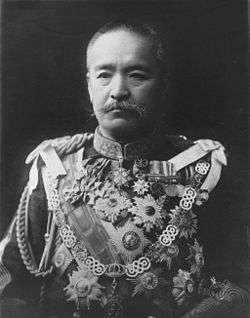 |
3rd Itō | 12 January 1898 | 30 June 1898 |
| 10 | Katsura Tarō |  |
1st Ōkuma | 30 June 1898 | 8 November 1898 |
| 11 | Katsura Tarō |  |
2nd Yamagata | 8 November 1898 | 19 October 1900 |
| 12 | Katsura Tarō |  |
4th Itō | 19 October 1900 | 23 December 1900 |
| 13 | Kodama Gentarō |  |
4th Itō | 23 December 1900 | 2 June 1901 |
| 14 | Kodama Gentarō |  |
1st Katsura | 2 June 1901 | 27 March 1902 |
| 15 | Terauchi Masatake | 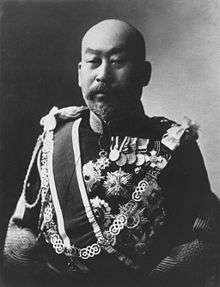 |
1st Katsura | 27 March 1902 | 7 January 1906 |
| 16 | Terauchi Masatake |  |
1st Saionji | 7 January 1906 | 14 July 1908 |
| 17 | Terauchi Masatake |  |
2nd Katsura | 14 July 1908 | 30 August 1911 |
| 18 | Ishimoto Shinroku | 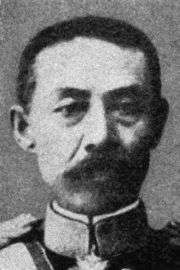 |
2nd Saionji | 30 August 1911 | 2 April 1912 |
| 19 | Uehara Yūsaku |  |
2nd Saionji | 5 April 1912 | 21 December 1912 |
| 20 | Kigoshi Yasutsuna |  |
3rd Katsura | 21 December 1912 | 20 February 1913 |
| 21 | Kigoshi Yasutsuna |  |
1st Yamamoto | 20 February 1913 | 24 June 1913 |
| 22 | Kusunose Yukihiko |  |
1st Yamamoto | 24 June 1913 | 16 April 1914 |
| 23 | Oka Ichinosuke |  |
2nd Ōkuma | 16 April 1914 | 30 March 1916 |
| 24 | Ōshima Ken'ichi | 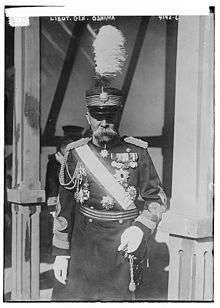 |
2nd Ōkuma | 30 March 1916 | 9 October 1916 |
| 25 | Ōshima Ken'ichi |  |
Terauchi | 9 October 1916 | 29 September 1918 |
| 26 | Tanaka Giichi |  |
Hara | 29 September 1918 | 9 June 1921 |
| 27 | Yamanashi Hanzō | 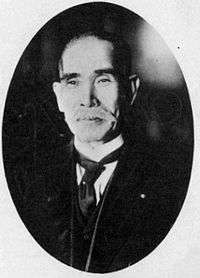 |
Hara | 9 June 1921 | 13 November 1921 |
| 28 | Yamanashi Hanzō |  |
Takahashi | 13 November 1921 | 12 June 1922 |
| 29 | Yamanashi Hanzō |  |
Katō | 12 June 1922 | 2 September 1923 |
| 30 | Tanaka Giichi |  |
2nd Yamamoto | 2 September 1923 | 7 January 1924 |
| 31 | Kazushige Ugaki |  |
Kiyoura | 7 January 1924 | 11 June 1924 |
| 32 | Kazushige Ugaki |  |
Katō | 11 June 1924 | 30 January 1926 |
| 33 | Kazushige Ugaki |  |
1st Wakatsuki | 30 January 1926 | 20 April 1927 |
| 34 | Yoshinori Shirakawa |  |
1st Tanaka | 20 April 1927 | 2 July 1929 |
| 35 | Kazushige Ugaki |  |
Hamaguchi | 2 July 1929 | 14 April 1931 |
| 36 | Jirō Minami |  |
2nd Wakatsuki | 14 April 1931 | 13 December 1931 |
| 37 | Sadao Araki |  |
Inukai | 13 December 1931 | 26 May 1932 |
| 38 | Sadao Araki |  |
Saitō | 26 May 1932 | 23 January 1934 |
| 39 | Senjūrō Hayashi |  |
Saitō | 23 January 1934 | 8 July 1934 |
| 40 | Senjūrō Hayashi |  |
Okada | 8 July 1934 | 5 September 1935 |
| 41 | Yoshiyuki Kawashima | |
Okada | 5 September 1935 | 9 March 1936 |
| 42 | Hisaichi Terauchi | 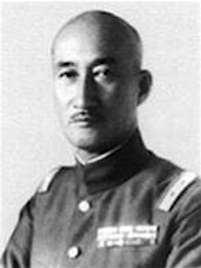 |
Hirota | 9 March 1936 | 2 February 1937 |
| 43 | Kōtarō Nakamura |  ] ] |
Hayashi | 2 February 1937 | 9 February 1937 |
| 44 | Sugiyama Hajime |  |
Hayashi | 9 February 1937 | 4 June 1937 |
| 45 | Sugiyama Hajime |  |
1st Konoe | 4 June 1937 | 3 June 1938 |
| 46 | Seishirō Itagaki |  |
1st Konoe | 3 June 1937 | 5 January 1939 |
| 47 | Seishirō Itagaki |  |
1st Hiranuma | 5 January 1939 | 30 August 1939 |
| 48 | Shunroku Hata | 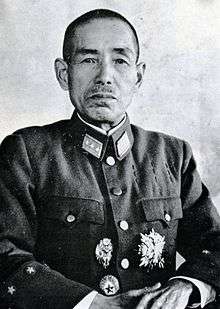 |
Abe | 30 August 1939 | 16 January 1940 |
| 49 | Shunroku Hata |  |
Yonai | 16 January 1940 | 22 July 1940 |
| 50 | Hideki Tojo |  |
2nd Konoe | 22 July 1940 | 18 July 1941 |
| 51 | Hideki Tojo |  |
3rd Konoe | 18 July 1941 | 18 October 1941 |
| 52 | Hideki Tojo |  |
Tojo | 18 October 1941 | 22 July 1944 |
| 53 | Sugiyama Hajime |  |
Koiso | 22 July 1944 | 7 April 1945 |
| 54 | Korechika Anami | 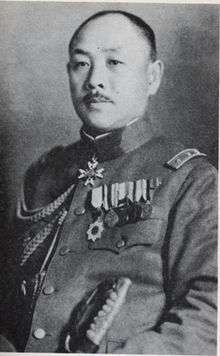 |
Suzuki | 7 April 1945 | 14 August 1945 |
| 55 | Prince Naruhiko Higashikuni |  |
Higashikuni | 17 August 1945 | 23 August 1945 |
| 56 | Sadamu Shimomura |  |
Higashikuni | 23 August 1945 | 9 October 1945 |
| 57 | Sadamu Shimomura |  |
Shidehara | 9 October 1945 | 1 December 1945 |
References
- Edgerton, Robert B. (1999). Warriors of the Rising Sun: A History of the Japanese Military. Westview Press. ISBN 0-8133-3600-7.
- Harries, Meirion (1994). Soldiers of the Sun: The Rise and Fall of the Imperial Japanese Army. Random House. ISBN 0-679-75303-6.
- "Foreign Office Files for Japan and the Far East". Adam Matthew Publications. Accessed 2 March 2005.
